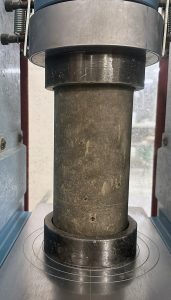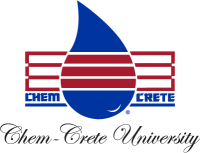Research
Chem-Crete R&D Cooperations with Universities
- University of Texas at Arlington (UTA), Texas, USA
- Iowa State University (National Concrete Pavement Technology Center, Institute for Transportation), Ames, Iowa, USA.
- University of Kentucky (Kentucky Transportation Center, College of Engineering), Lexington, Kentucky, USA
- University of Missouri – Kansas City (UMKC), Missouri, USA
- Brunel University London, UK
- City University, London, UK
- Clemson University, Clemson, South Carolina, USA
Chem-Crete, capitalizing on science and technology, believes in creating cooperation bridges with academic institutions and research centers at universities as well as independent material testing laboratories.
Over the past two decades, Chem-Crete technology has been investigated by various research centers for US departments of transportations (DOT’s). Furthermore, Chem-Crete has implemented and funded various research programs for investigating the performances of waterproofing and asphalt sealer products. These research programs led to theses of graduate students at US universities. As outputs of these cooperation programs, tens of papers that document the performance of Chem-Crete technology were published. These include peer-reviewed papers by third party investigators and papers and book chapters by the Chem-Crete Team.

Theses of Graduate Students Investigating Chem-Crete PaviX
- Shakya, Roshan, “Water damage evaluation of concrete infrastructure”, Department of Civil and Environmental Engineering, The University of Texas at Arlington, Texas, USA, 2005.
- Hashemi Senejani, “An Experimental Investigation Of Icephobicity And Hydrophobicity Of Concrete Surface Treated With PAVIX”, Department of Civil and Environmental Engineering, The University of Texas at Arlington, Texas, USA, 2022.
Peer-Reviewed Papers Published by Third Party Investigator
- Chamberlain, D.A. and L.F. Boswell, The Use of Pavix CCC100 as a Reinforced Concrete Impregnate and as an Alternative to Silane, in Performance Based Rehabilitation Of Reinforced Concrete Structures Conference. 2005: Prague, Czech Republic.
- Rahman, M., et al., Moisture efficacy of impregnant in concrete protection, in Transportation Research Board 95th Annual Meeting. 2016: Washington DC, United States.
- Rahman, M. and D. Chamberlain, Application of crystallising hydrophobic mineral and curing agent to fresh concrete. Construction and Building Materials, 2016. 127: p. 945-949.
- Rahman, M. and D. Chamberlain, Performance of crystalline hydrophobic in wet concrete protection. Journal of Materials in Civil Engineering, 2017. 29(6): p. 04017008.
- Al-Kheetan, M.J., M.M. Rahman, and D.A. Chamberlain, A novel approach of introducing crystalline protection material and curing agent in fresh concrete for enhancing hydrophobicity. Construction and Building Materials, 2018. 160: p. 644-652.
- Al-Kheetan, M.J., M.M. Rahman, and D.A. Chamberlain, Remediation and protection of masonry structures with crystallising moisture blocking treatment. International Journal of Building Pathology and Adaptation, 2018. 36(1): p. 77-92.
- Al-Kheetan, M.J., M.M. Rahman, and D.A. Chamberlain, Development of hydrophobic concrete by adding dual-crystalline admixture at mixing stage. Structural Concrete, 2018.
- Al-Kheetan, M.J., M.M. Rahman, and D.A. Chamberlain, Moisture evaluation of concrete pavement treated with hydrophobic surface impregnants. International Journal of Pavement Engineering, 2019: p. 1-9.
- Al-Kheetan, M.J., M.M. Rahman, and D.A. Chamberlain, Fundamental interaction of hydrophobic materials in concrete with different moisture contents in saline environment. Construction and Building Materials, 2019. 207: p. 122-135.
- Rahman, M. and M. Al-Kheetan, Integration of Anhydrous Sodium Acetate (ASAc) into Concrete Pavement for Protection Against Harmful Impact of De-icing Salt. 2019.
- Al-Kheetan, M.J., M.M. Rahman, and D.A. Chamberlain, A-2-4 Comparative study of different hydrophobic materials in concrete pavement protection. 2019.
- Al-Kheetan, M.J., et al., Comprehensive investigation of the long-term performance of internally integrated concrete pavement with sodium acetate. Results in Engineering, 2020. 6: p. 100110.
- Al-Kheetan, M.J., et al., Development of low absorption and high-resistant sodium acetate concrete for severe environmental conditions. Construction and Building Materials, 2020. 230: p. 117057.
- Al‐Kheetan, M.J., et al., Resistance of hydrophobic concrete with different moisture contents to advanced freeze–thaw cycles. Structural Concrete, 2020. 22: p. E1050-E1061.
- Mazen, A.-K., M. Rahman, and S. Ghaffar. Advanced Freeze-Thaw Assessment of Internally Integrated Concrete with Sodium Acetate. in International Conference on Civil Infrastructure and Construction (CIC 2020). 2020.
- Adil, Goran, Seyedhamed Sadati, Yifeng Ling, Peter Taylor, Kejin Wang, and John T. Kevern. “Penetrating Sealer Effects on Durability Performance of Concrete Joints.” Materials Journal 119, no. 6 (2022): 43-52.
- Adil, Goran, John T. Kevern, and Danny X. Xiao. “Influence of Penetrating Sealer on Performance of Concrete Joints.” ACI Materials Journal 118, no. 5 (2021).
- Al-Kheetan, Mazen J., Mujib M. Rahman, and Denis A. Chamberlain. “Influence of early water exposure on modified cementitious coating.” Construction and Building Materials 141 (2017): 64-71.
